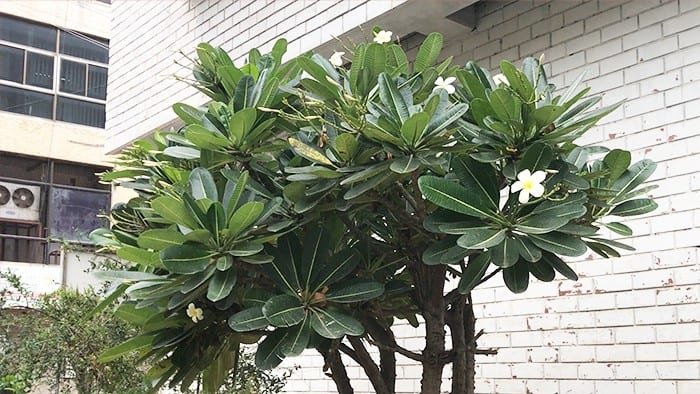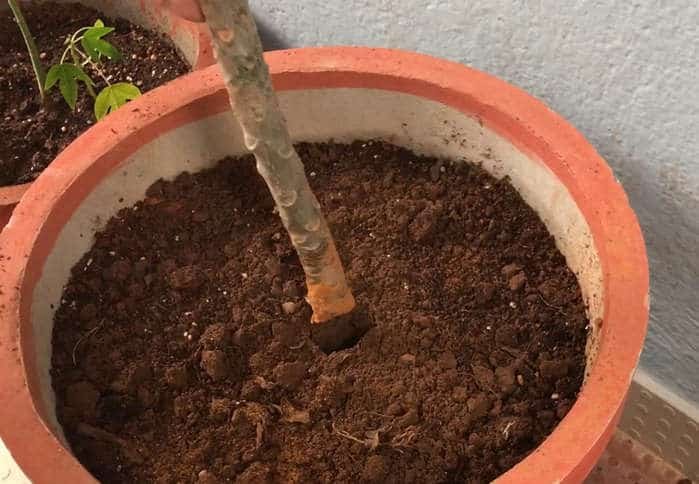Contents
We will show you some important Plumeria plant care tips and its propagation from cuttings with results.

Overview of Plumeria
Plumeria are milky sap plants and consist of a lot of species, all belonging to the Apocynaceae family. Examples include Plumeria Pudica, Plumeria Alba, and Plumeria Obtusa. The various species differ in their leaf shape, arrangement, and flower color. Common names for this plant include Champa, Nag Champa, Pigeon wood, and caterpillar tree.
Types of Plumeria
Plumeria Obtusa
- Common Name: White Champa
- Flower Color: White
Plumeria Pudica
- Common Name: Naag Champa
- Leaf Shape: Resembles the hood of a cobra snake
Care Tips for Plumeria Plants
General Care
Regardless of the species, these are the common care tips for all plumerias. With the proper care, these wonderful tropical plants can live for many years in containers and can grow very tall when planted in ground soil.
Watering Requirements
- Plumerias like a lot of water during their active growing season (spring and summer), but be careful with overwatering as this can lead to rot and kill the plant.
- The best method is to dip your finger about an inch into the soil; if it’s dry, then water the plant thoroughly.
- This depends on your climatic zone and season, and whether you have kept it in full sun. You may need to water daily or on alternate days.
- Use clay pots instead of plastic pots if you are keeping the plant in full direct sunlight.
Sunlight
- For best flowering, keep it in full direct sunlight, preferably for at least 4 to 6 hours daily.
- Depending on your climatic zone, some regions might need to shift the plant indoors during winter when it goes into dormancy.
Soil
- Use a well-draining soil mix to make care easier and to promote maximum flowering.
- Check the drainage holes of your pot and unclog them if necessary.
- A general potting soil, like a universal potting mix, will work well for this plant.
Fertilizer
- Plumerias are heavy feeders, especially when grown in pots.
- Fertilize once every 15 days to 1 month during spring and summer for best results.
- Recommended fertilizers:
- One handful of vermicompost or decomposed cowdung powder
- NPK crystals (5 to 10 crystals) or water-soluble NPK 19-19-19 powder
- Bone meal (1–2 teaspoons every 2 months)
- Compost tea
- Use a universal mixed fertilizer powder (about 1 tablespoon) every 15 days after tilling or raking the soil.
Pest Control
- Plumerias are rarely attacked by whiteflies and spider mites.
- Use neem oil spray when attacked or as a preventative measure once a month.
- Neem oil solution: 5ml neem oil in 1 liter of water + half teaspoon or 10 drops of liquid soap.
Pruning
- Prune from time to time to promote good growth and more flowers.
- Prune branches after a bunch of flowers dry out to encourage more growth and flowering.
Propagation

- Plumerias are easy to propagate from cuttings.
- Be careful with the milky sap, as it can be a skin irritant.
- Dry the cutting for 2–3 days to form a callous at the cut end before planting.
- Success rate is high, but sometimes rooting can be delayed, taking months before showing signs of growth.
By following these care tips, you can enjoy the beauty and fragrance of Plumeria plants in your garden or home.
Video Tutorial On Plumeria Plant Care
Please watch video below on care tips for plumeria tree.

1 comment
In the summer…Do you Water the calloused-cutting while in the pot, while it is trying to root?
I know initially you do, but what if it drys out after the initial watering??
2nd Question: Can i leave the cutting that is trying to root in a sunny location? or…does it need to be in a dark location? Curious